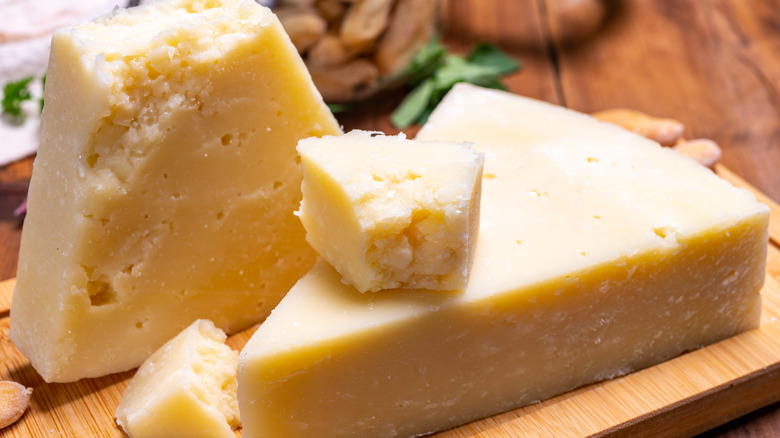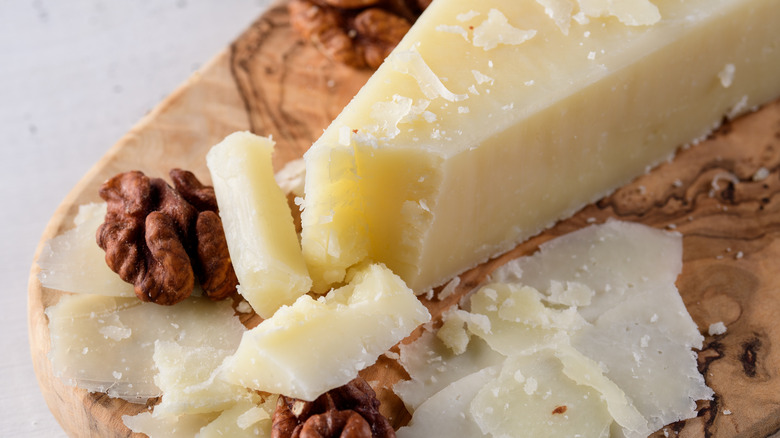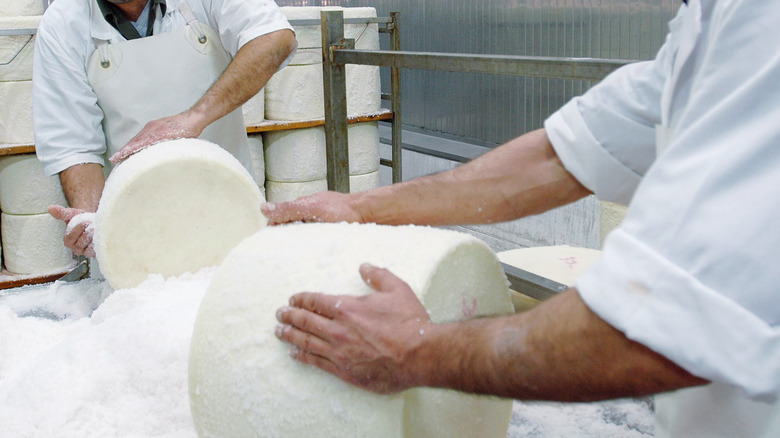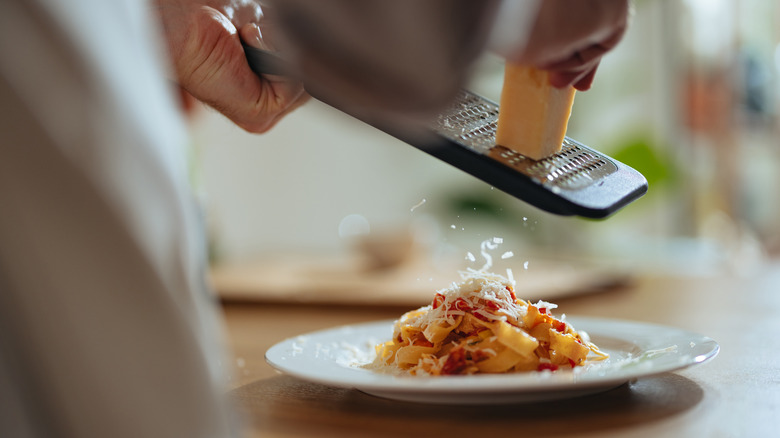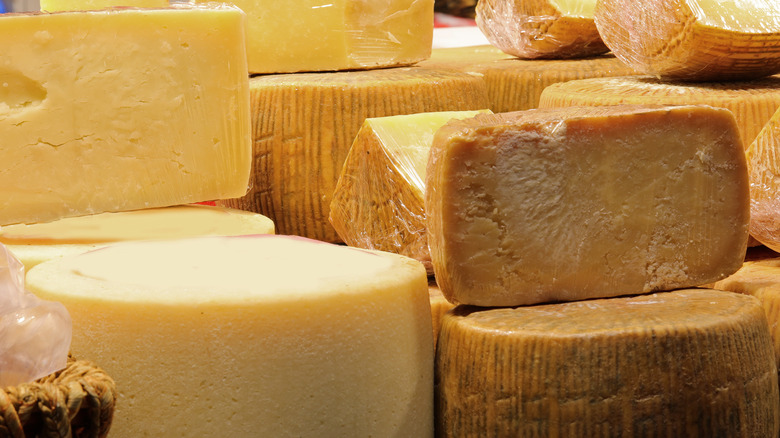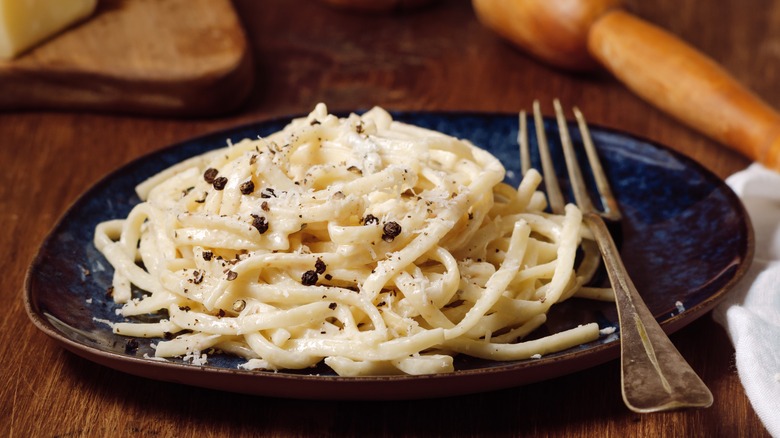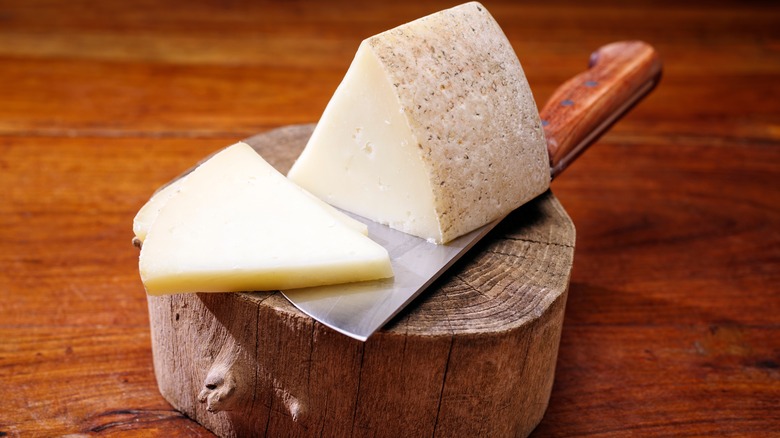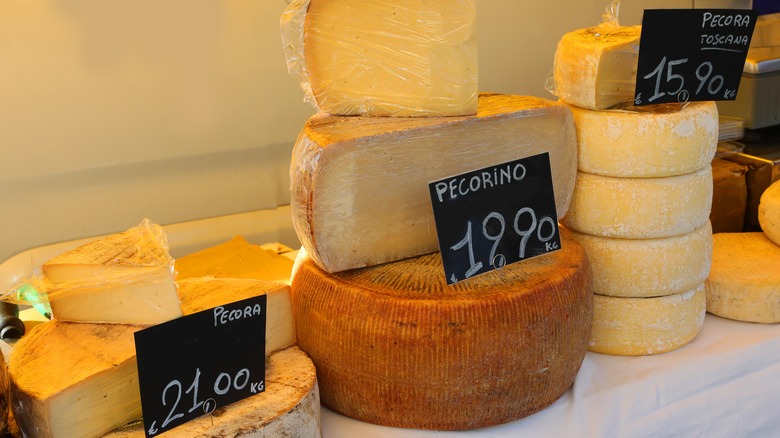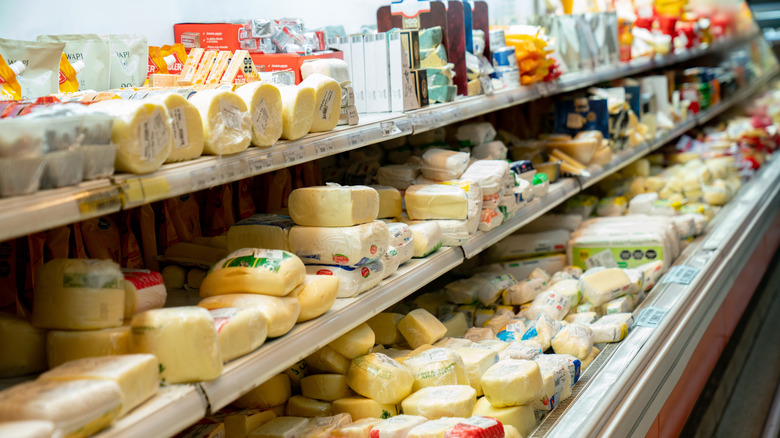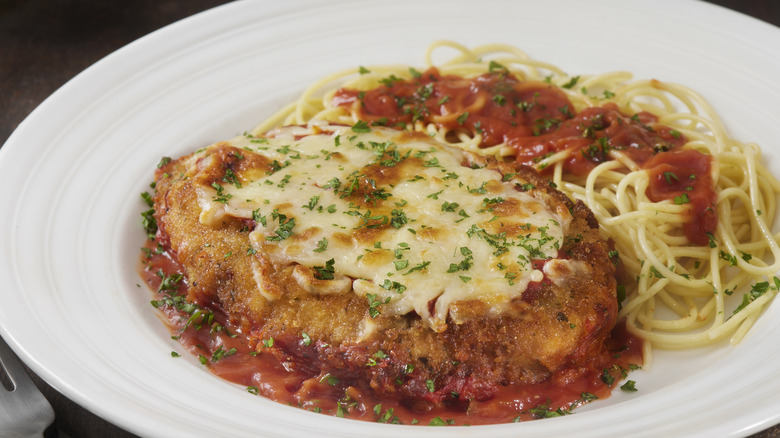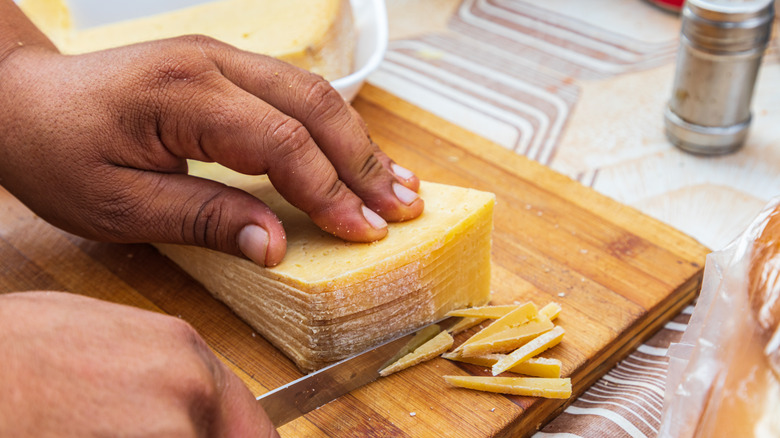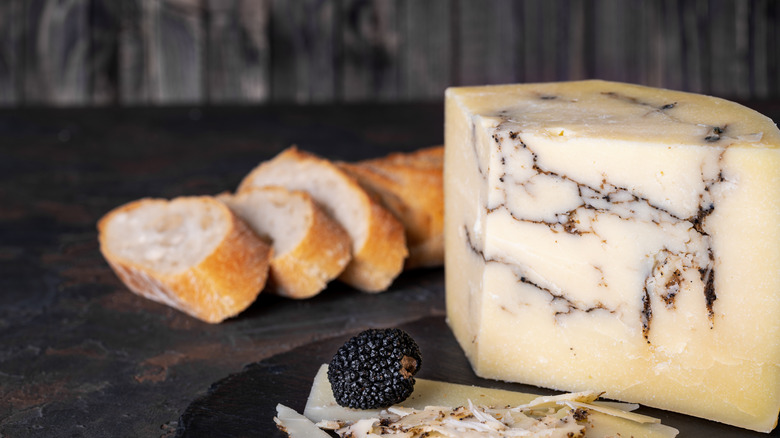What Is Pecorino Romano And What Does It Taste Like?
There are so many different types of cheese to choose from for all of your culinary needs, but one of the most beloved and most integral to Italian cooking is Pecorino Romano.
Pecorino Romano is very distinct and, like many other Protected Designation of Origin (PDO) cheeses, is made with very similar techniques and ingredients as it was several hundred years ago. Its salty flavor and dry, grainy texture make it the cornerstone ingredient for dishes like cacio e pepe, as well as a common snacking cheese for charcuterie boards far and wide.
But how much do you really know about Pecorino Romano, and what makes it different from other cheeses? After all, there's more to this cheese than just an earthy smell and divine texture. We're here to explore the ins and outs of this ancient cheese and all of its different varieties so that you can put it to good use in your kitchen.
What is Pecorino Romano?
Pecorino Romano is a sheep's milk cheese that is produced exclusively in Italy, primarily in Lazio, Sardinia, and Tuscany. The cheese's texture is relatively hard, compared to a soft cheddar or mozzarella, so it can be grated or peeled as a garnish on pasta and salads, as well as used as a flavoring agent on pasta dishes. You can identify Pecorino Romano by its creamy white color and straw-colored rind. However, the color of the rind can be slightly different depending on how long the cheese is aged and based on the conditions at the time the cheese was produced. You'll also notice that this cheese has a limited number of holes because of its cutting and cooking process.
Pecorino Romano is a staple in Italy, but you can also get your hands on it through cheesemongers and retailers around the world. It's used for many different pasta dishes, including the famous cacio e pepe, or eaten out by hand with a good glass of wine.
How is Pecorino Romano made?
One of the most distinguishing characteristics of Pecorino Romano is that it's a sheep's milk cheese. But these sheep aren't just any sheep: They must be grass-fed and bred in the wild before the milk is collected and used for cheesemaking.
The first step in the cheesemaking process is to cook and combine the milk with rennet, a medley of enzymes sourced from the stomach of some ruminants. In the case of Pecorino Romano, this rennet comes from sheep. Rennet is an important ingredient in the cheesemaking process because it coagulates the curds and separates them from the liquid whey.
Once the curds have been separated from the whey, they are cut into small pieces before being shaped into large drums so that the remaining whey can be extracted. Once the cheese is pressed into the shape, it can be wrapped and salted to both flavor it and discourage the growth of microorganisms. This process can take upwards of 80 to 100 days and will, at first, involve salting the rind daily to develop its flavor.
The aging process on Pecorino Romano varies but typically lasts 8 to 12 months. Once the cheese has sat for five months, it can be marketed as a table cheese. By the eighth month, it can be sold as a grating cheese, because aging and salting zaps the moisture out.
What does the cheese taste like?
Pecorino Romano has a very distinct, dry flavor. But the more specific taste is dependent on how long the cheese is aged. Fresh cheese has the least mature flavor, while semi-stagionato (semi-aged) and stagionato (aged) have more profound, sharp notes. The younger the cheese, the creamier and softer it is, which makes it better for snacking or adding to a sandwich, while the latter is better for sprinkling on a pasta dish.
The flavor of Pecorino Romano is often dependent on the palate of the person eating it. Some people have noted that the flavor of this cheese is smoky and subtly spicy, while others only decipher its salty flavor. Someone who is very well-versed in cheese will also pick up that it is very oily because of its high butterfat content. You may even notice so-called "butterfat tears" in the cheese that are entirely natural and indicative that the cheese is at the ideal temperature for eating.
How is Pecorino Romano different from parmesan?
Pecorino Romano and Parmigiano-Reggiano are often lumped together as the same type of cheese. But in fact, this is far from being true. Unlike Pecorino Romano, which is made from sheep's milk, Parmigiano-Reggiano is derived from less fatty cow's milk. Parmigiano-Reggiano also has a longer aging process, which can take upwards of two years, allowing it to develop a robust flavor with saltier notes. In comparison, Pecorino Romano is milder in flavor with a more pronounced tang.
One similarity between Pecorino Romano and Parmigiano-Reggiano is that they both have Protected Designation of Origins. In the same way that Pecorino Romano is tied to a specific location and is made with specific tools and techniques, Parmigiano-Reggiano must be produced using standards outlined in its own PDO rules. Cheeses made outside of this region or process cannot be marketed to consumers as Parmigiano-Reggiano. However, cheeses marketed as just "pecorino" or "parmesan" do not have to adhere to these standards.
What varieties of Pecorino Romano are there?
There are several different varieties nestled under the Pecorino Romano cheese umbrella. For example, Sardinian Pecorino cheese is a Tuscan specialty. It's believed that the Sardinians were the first to create the pecorino cheese style and used the Sarda sheep's milk to craft their take on the cheese. The Sardinians also stick to animal-based rennet to make their cheeses, while the Tuscan cheesemakers use vegetable-based rennet instead.
Lazio's version of the cheese, which is sold as Pecorino Romano ("Romano" meaning "Rome"), has a much sharper and more salty flavor than other varieties. There are also other types of Pecorino cheese, like Pecorino Sardo (from Sardinia), which is smoked and has a sweeter flavor. Pecorino Toscano is often the softest variety and is often used as a table cheese due to its unctuous texture and mild flavor, but it will develop more complex, nutty notes as it ages. We also recommend making a trip to Sicily for Pecorino Siciliano, a milder version of the cheese that often contains a surprise of texture and flavor from pistachios or truffles.
How was Pecorino Romano historically used?
Pecorino Romano was an ingredient used in Italian cooking long before Trader Joe's cacio e pepe sauce went viral on TikTok. The ancient Romans utilized cheese as a key source of fat and protein, especially for the empire's growing military power. At one point, the daily ratio for Roman soldiers included a whopping 27 grams of cheese.
Sardinia remains one of the predominant growing regions for sheep, even long after the Roman empire crumbled. Shepherds switched from raising their flocks outside of Rome to the island after they recognized that the endemic sheep could graze on the lush vegetation on the islands. According to Italy Magazine, close to 96% of the milk used for Pecorino Romano in the country comes from sheep reared on Sardinia. The magazine estimates that there are nearly 1.3 million more sheep than there are people on the island, which makes for a seemingly endless source of milk for the region's cheesemaking.
Pecorino Romano is a staple in cacio e pepe
Pecorino Romano is the type of cheese always used in cacio e pepe. Besides the cheese, the recipe also marries the consistency of perfectly cooked pasta with the sharpness of freshly cracked pepper. Moreover, the pepper can be bloomed in butter to fully round out the flavor and balance out the salty sharpness of the Pecorino Romano. To help the cheese stick to the pasta, you'll want to toss some pasta water in with the butter. And although our recipe for classic cacio e pepe also uses Parmigiano-Reggiano, the main star of the show should be the Pecorino Romano.
The connection between this classic pasta dish and the region where Pecorino Romano was created is deeply rooted in history. It was likely made as a way for nomadic shepherds to use up the perishable cheese by combining it with non-perishable seasonings and pasta. The dish is both filling and relatively inexpensive to make, considering that the cheese was plentiful.
How to keep Pecorino Romano fresh
Despite being an aged cheese, Pecorino Romano is still perishable and should be stored correctly to extend its shelf life. Once a piece of the cheese has been cut, it can last for three to four weeks in a refrigerator drawer. After the cheese is grated, it should be used within three to four days.
Grating your cheese increases its surface area, which increases the opportunity it has to go stale faster. It's best to avoid adding pre-grated cheese to your recipes because the grana or shreds often contain stabilizers and fillers to prevent the cheese from sticking to itself. We also recommend using a cold block of cheese for grating because it will hold together much easier. Then, run it against a microplane to get the perfect particulate size. With one of these handy kitchen tools on hand, you can grate your cheese on demand and add Pecorino Romano to all of your favorite Italian dishes.
How to be sure your Pecorino Romano is authentic
Since Pecorino Romano is a PDO cheese, you'll want to be sure you're getting the real thing — and paying for what you think you're paying for. You can tell authentic Pecorino Romano apart from imposters by the printing on the side of the cheese. Each of the rounds should have a flat bottom and top with a logo stamped on the side. This distinct design features a diamond with rounded corners encasing a sheep's head and the name "Pecorino Romano" stamped onto it. You'll also notice that the round has a distinct PDO label on it, along with the initials of the producer and production date.
The only problem is that consumers rarely purchase cheese in 45 to 80-pound rounds. You can look for the gold and red PDO labels on the side of the package and the label that indicates the cheese was imported from Italy. It's important, though, not to make the critical mistake of mixing up Romano cheese, which is made from cow's milk, and true sheep's milk Pecorino Romano.
Where to buy Pecorino Romano
There are numerous retailers where you can buy Pecorino Romano — and most of them won't require you to deviate from your usual grocery store routine. The cheese counter at your local store will be the best place to find a wedge or (albeit less optimal) pre-grated Pecorino Romano. You can also make a trip to a specialty cheese shop to track down a wedge. We've found that these cheese stores have a well-established understanding of what customers are looking for in terms of the flavor, age, and consistency of their products, which primes them to give a recommendation for which type of Pecorino Romano to purchase.
If you don't have a local cheese shop or your grocery store is lacking in selection, you can find an online cheese merchant to purchase from. These retailers will ship quality, imported cheese to your door with the click of a button.
Purchase Locatelli Pecorino Romano (1 pound) on Frank and Sal for $32.98
Purchase Pecorino Romano (7 ounces) on Gourmet Food World for $14.27
Purchase Locatelli Pecorino Romano (1 pound) on DiGiacomo Bros. for $19.95
How to substitute Pecorino Romano
Sometimes you just can't get your hands on a wedge of Pecorino Romano. But the good news is that there are some quick substitutes you can make. Instead of Pecorino Romano, switch to parmesan or the PDO-ed Parmigiano-Reggiano. This cheese variety has the most similar dryness and salty flavor to the Pecorino Romano. However, parmesan is much saltier, so you may have to cut back on other salty ingredients, like table salt or capers to accommodate for this difference.
Another option that may be a good substitute for Pecorino Romano is Piave. It's aged for a shorter amount of time than parmesan, so it has a milder flavor. Although it is also made from cow's milk, it mimics the same mild flavor of the Pecorino Romano and makes for an unobtrusive addition to the top of pasta, salads, or pizza.
Can you eat the rind?
Many people are quick to remove Pecorino Romano's thick rind. This hard casing naturally forms during the aging process as the cheese is exposed to air. After the aging is complete, the cheesemaker is left with a protective case around the outside of the softer cheese. Although there is a noticeable textural difference between the rind and the inside of the cheese, it is perfectly safe to eat the rind. As long as there is no synthetic wax or paper on the outside of the cheese, you can feel free to use it in your dishes.
Although the rind is safe for consumption, many people don't like its texture. Instead of snacking on the rind, try adding it to a simmering pot of your favorite stew to extract the umami and salt flavors. It's a great addition to any creamy Italian soup, and you can always strain out the piece after it has sufficiently cooked down.
What are good accompaniments for the cheese?
There are tons of options for pairing this cheese outside of a dish of cacio e pepe. If you have a young Pecorino Romano, you can add it to your charcuterie board for a salty, spicy bite.
The best accompaniments to pair with pecorino cheese are salty flavors, like pickled giardiniera or green olives. Pecorino, which is a bit drier due to its longer aging timeline, also has more fatty notes, which can be complemented with a bowl of roasted almonds or walnuts. We also recommend adding a sweet addition to the board to balance out the savory notes of the cheese. Crackers with a sweet jam or a few pieces of dark chocolate can provide flavorful and textural contrasts to your charcuterie and cleanse your palate.
Accompaniments don't just have to mean food, either. Pecorino Romano is relatively easy to pair with your favorite wine, too. A fruity Barolo or Chianti will cut the saltiness of the cheese, and a riesling or sauvignon blanc can satisfy the palate of cheese-loving, white wine enthusiasts.
Is Pecorino Romano healthy?
Since Pecorino Romano is often used as a sprinkling cheese or small cheeseboard accompaniment, its nutritional profile is not often relevant. Regardless, one ounce of Pecorino Romano cheese has 110 calories, 8 grams of protein, and 9 grams of fat.
Pecorino Romano made with animal rennet is not vegetarian, but cheese made with vegetable rennet sourced from cardoon thistle, artichokes, or nettles may be. These plant-based rennets are more common in Portuguese and Spanish cheeses, while most traditional Italian cheesemakers will stick to the animal rennet. Plus, the PDO distinction limits what kind of rennet can be used in the traditional cheesemaking practice, which means that vegetarians may never be able to get their hands on the official version of this cheese without deviating from their diet. Most Pecorino Romano cheeses are also gluten-free, but the products may be made in a facility that also processes gluten, so they may not be suitable for those with severe gluten allergies or celiac disease.
